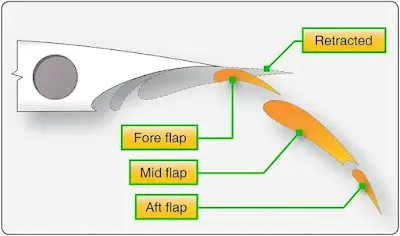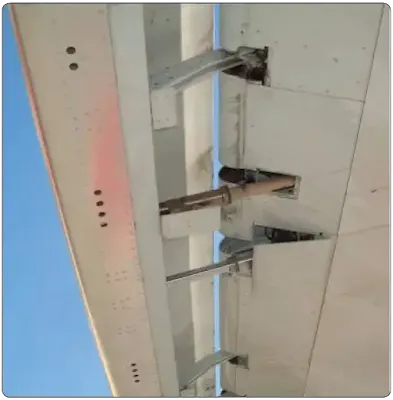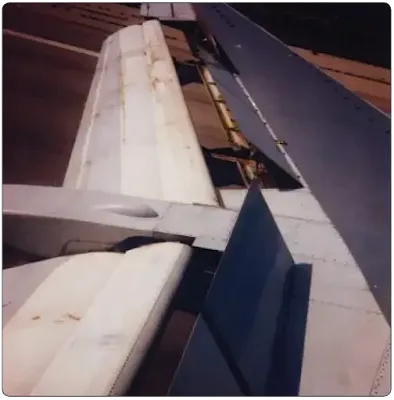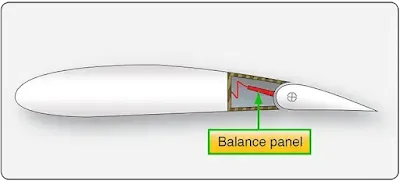There are several secondary or auxiliary flight control surfaces. Their names, locations, and functions of those for most large aircraft are listed in Figure 1.
| Secondary/Auxiliary Flight Control Surfaces | ||
|---|---|---|
| Name | Location | Function |
| Flaps | Inboard trailing edge of wings | Extends the camber of the wing for greater lift and slower flight. Allows control at low speeds for short field takeoffs and landings. |
| Trim tabs | Trailing edge of primary flight control surfaces | Reduces the force needed to move a primary control surface. |
| Balance tabs | Trailing edge of primary flight control surfaces | Reduces the force needed to move a primary control surface. |
| Anti-balance tabs | Trailing edge of primary flight control surfaces | Increases feel and effectiveness of primary control surface. |
| Servo tabs | Trailing edge of primary flight control surfaces | Assists or provides the force for moving a primary flight control. |
| Spoilers | Upper and/or trailing edge of wing | Decreases (spoils) lift. Can augment aileron function. |
| Slats | Mid to outboard leading edge of wing | Extends the camber of the wing for greater lift and slower flight. Allows control at low speeds for short field takeoffs and landings.0 |
| Slots | Outer leading edge of wing forward of ailerons | Directs air over upper surface of wing during high angle of attack. Lowers stall speed and provides control during slow flight. |
| Leading edge flap | Inboard leading edge of wing | Extends the camber of the wing for greater lift and slower flight. Allows control at low speeds for short field takeoffs and landings. |
| NOTE: An aircraft may possess none, one, or a combination of the above control surfaces. | ||
Figure 1. Secondary or auxiliary control surfaces and respective locations for larger aircraft
Flaps
Flaps are found on most aircraft. They are usually inboard on the wings’ trailing edges adjacent to the fuselage. Leading edge flaps are also common. They extend forward and down from the inboard wing leading edge. The flaps are lowered to increase the camber of the wings and provide greater lift and control at slow speeds. They enable landing at slower speeds and shorten the amount of runway required for takeoff and landing.
The amount that the flaps extend and the angle they form with the wing can be selected from the cockpit. Typically, flaps can extend up to 45–50°. Figure 2 shows various aircraft with flaps in the extended position.
The amount that the flaps extend and the angle they form with the wing can be selected from the cockpit. Typically, flaps can extend up to 45–50°. Figure 2 shows various aircraft with flaps in the extended position.
 |
| Figure 2. Various aircraft with flaps in the extended position |
Flaps are usually constructed of materials and with techniques used on the other airfoils and control surfaces of a particular aircraft. Aluminum skin and structure flaps are the norm on light aircraft. Heavy and high-performance aircraft flaps may also be aluminum, but the use of composite structures is also common.
There are various kinds of flaps. Plain flaps form the trailing edge of the wing when the flap is in the retracted position. [Figure 3A] The airflow over the wing continues over the upper and lower surfaces of the flap, making the trailing edge of the flap essentially the trailing edge of the wing. The plain flap is hinged so that the trailing edge can be lowered. This increases wing camber and provides greater lift.
Occasionally, a simple light aircraft may have a stationary metal plate attached to the trailing edge of a primary flight control, usually the rudder. This is also a trim tab as shown in Figure 10. It can be bent slightly on the ground to trim the aircraft in flight to a hands-off condition when flying straight and level. The correct amount of bend can be determined only by flying the aircraft after an adjustment. Note that a small amount of bending is usually sufficient.
[Figure 15] When the aileron is moved from the neutral position, differential pressure builds up on one side of the balance panel. This differential pressure acts on the balance panel in a direction that assists the aileron movement. For slight movements, deflecting the control tab at the trailing edge of the aileron is easy enough to not require significant assistance from the balance tab. (Moving the control tab moves the ailerons as desired.) But, as greater deflection is requested, the force resisting control tab and aileron movement becomes greater and augmentation from the balance tab is needed. The seals and mounting geometry allow the differential pressure of airflow on the balance panel to increase as deflection of the ailerons is increased. This makes the resistance felt when moving the aileron controls relatively constant.
RELATED POSTS
There are various kinds of flaps. Plain flaps form the trailing edge of the wing when the flap is in the retracted position. [Figure 3A] The airflow over the wing continues over the upper and lower surfaces of the flap, making the trailing edge of the flap essentially the trailing edge of the wing. The plain flap is hinged so that the trailing edge can be lowered. This increases wing camber and provides greater lift.
 |
| Figure 3. Various types of flaps |
A split flap is normally housed under the trailing edge of the wing. [Figure 3B] It is usually just a braced flat metal plate hinged at several places along its leading edge. The upper surface of the wing extends to the trailing edge of the flap. When deployed, the split flap trailing edge lowers away from the trailing edge of the wing. Airflow over the top of the wing remains the same. Airflow under the wing now follows the camber created by the lowered split flap, increasing lift.
Fowler flaps not only lower the trailing edge of the wing when deployed but also slide aft, effectively increasing the area of the wing. [Figure 3C] This creates more lift via the increased surface area, as well as the wing camber. When stowed, the fowler flap typically retracts up under the wing trailing edge similar to a split flap. The sliding motion of a fowler flap can be accomplished with a worm drive and flap tracks.
Fowler flaps not only lower the trailing edge of the wing when deployed but also slide aft, effectively increasing the area of the wing. [Figure 3C] This creates more lift via the increased surface area, as well as the wing camber. When stowed, the fowler flap typically retracts up under the wing trailing edge similar to a split flap. The sliding motion of a fowler flap can be accomplished with a worm drive and flap tracks.
An enhanced version of the fowler flap is a set of flaps that actually contains more than one aerodynamic surface. Figure 4 shows a triple-slotted flap. In this configuration, the flap consists of a fore flap, a mid flap, and an aft flap. When deployed, each flap section slides aft on tracks as it lowers. The flap sections also separate leaving an open slot between the wing and the fore flap, as well as between each of the flap sections. Air from the underside of the wing flows through these slots. The result is that the laminar flow on the upper surfaces is enhanced. The greater camber and effective wing area increase overall lift.
 |
| Figure 4. Triple slotted flap |
Heavy aircraft often have leading edge flaps that are used in conjunction with the trailing edge flaps. [Figure 5] They can be made of machined magnesium or can have an aluminum or composite structure. While they are not installed or operate independently, their use with trailing edge flaps can greatly increase wing camber and lift. When stowed, leading edge flaps retract into the leading edge of the wing.
 |
| Figure 5. Leading edge flaps |
The differing designs of leading edge flaps essentially provide the same effect. Activation of the trailing edge flaps automatically deploys the leading edge flaps, which are driven out of the leading edge and downward, extending the camber of the wing. Figure 6 shows a Krueger flap, recognizable by its flat mid-section.
 |
| Figure 6. Side view (left) and front view (right) of a Krueger flap on a Boeing 737 |
Slats
Another leading-edge device which extends wing camber is a slat. Slats can be operated independently of the flaps with their own switch in the cockpit. Slats not only extend out of the leading edge of the wing increasing camber and lift, but most often, when fully deployed leave a slot between their trailing edges and the leading edge of the wing. [Figure 7] This increases the angle of attack at which the wing will maintain its laminar airflow, resulting in the ability to fly the aircraft slower and still maintain control.
 |
| Figure 7. Air passing through the slot aft of the slat promotes boundary layer airflow on the upper surface at high angles of attack |
Spoilers and Speed Brakes
A spoiler is a device found on the upper surface of many heavy and high-performance aircraft. It is stowed flush to the wing’s upper surface. When deployed, it raises up into the airstream and disrupts the laminar airflow of the wing, thus reducing lift.
Spoilers are made with similar construction materials and techniques as the other flight control surfaces on the aircraft. Often, they are honeycomb-core flat panels. At low speeds, spoilers are rigged to operate when the ailerons operate to assist with the lateral movement and stability of the aircraft. On the wing where the aileron is moved up, the spoilers also raise thus amplifying the reduction of lift on that wing. [Figure 8] On the wing with downward aileron deflection, the spoilers remain stowed. As the speed of the aircraft increases, the ailerons become more effective and the spoiler interconnect disengages.
Spoilers are made with similar construction materials and techniques as the other flight control surfaces on the aircraft. Often, they are honeycomb-core flat panels. At low speeds, spoilers are rigged to operate when the ailerons operate to assist with the lateral movement and stability of the aircraft. On the wing where the aileron is moved up, the spoilers also raise thus amplifying the reduction of lift on that wing. [Figure 8] On the wing with downward aileron deflection, the spoilers remain stowed. As the speed of the aircraft increases, the ailerons become more effective and the spoiler interconnect disengages.
 |
| Figure 8. Spoilers deployed upon landing on a transport category aircraft |
Spoilers are unique in that they may also be fully deployed on both wings to act as speed brakes. The reduced lift and increased drag can quickly reduce the speed of the aircraft in flight. Dedicated speed brake panels similar to flight spoilers in construction can also be found on the upper surface of the wings of heavy and high-performance aircraft. They are designed specifically to increase drag and reduce the speed of the aircraft when deployed. These speed brake panels do not operate differentially with the ailerons at low speed.
The speed brake control in the cockpit can deploy all spoiler and speed brake surfaces fully when operated. Often, these surfaces are also rigged to deploy on the ground automatically when engine thrust reversers are activated.
TabsThe force of the air against a control surface during the high speed of flight can make it difficult to move and hold that control surface in the deflected position. A control surface might also be too sensitive for similar reasons. Several different tabs are used to aid with these types of problems. The table in Figure 9 summarizes the various tabs and their uses.
| Flight Control Tabs | |||
|---|---|---|---|
| Type | Direction of Motion (in relation to control surface) | Activation | Effect |
| Trim | Opposite | Set by pilot from cockpit. Uses independent linkage. | Statically balances the aircraft in flight. Allows “hands off” maintenance of flight condition. |
| Balance | Opposite | Moves when pilot moves control surface. Coupled to control surface linkage. | Aids pilot in overcoming the force needed to move the control surface. |
| Servo | Opposite | Directly linked to flight control input device. Can be primary or back-up means of control. | Aerodynamically positions control surfaces that require too much force to move manually. |
| Anti-balance or Anti-servo | Same | Directly linked to flight control input device. | Increases force needed by pilot to change flight control position. De-sensitizes flight controls. |
| Spring | Opposite | Located in line of direct linkage to servo tab. Spring assists when control forces become too high in high-speed flight. | Enables moving control surface when forces are high. Inactive during slow flight. |
Figure 9. Various tabs and their uses
While in flight, it is desirable for the pilot to be able to take his or her hands and feet off of the controls and have the aircraft maintain its flight condition. Trims tabs are designed to allow this. Most trim tabs are small movable surfaces located on the trailing edge of a primary flight control surface. A small movement of the tab in the direction opposite of the direction the flight control surface is deflected, causing air to strike the tab, in turn producing a force that aids in maintaining the flight control surface in the desired position. Through linkage set from the cockpit, the tab can be positioned so that it is actually holding the control surface in position rather than the pilot. Therefore, elevator tabs are used to maintain the speed of the aircraft since they assist in maintaining the selected pitch. Rudder tabs can be set to hold yaw in check and maintain heading. Aileron tabs can help keep the wings level.Occasionally, a simple light aircraft may have a stationary metal plate attached to the trailing edge of a primary flight control, usually the rudder. This is also a trim tab as shown in Figure 10. It can be bent slightly on the ground to trim the aircraft in flight to a hands-off condition when flying straight and level. The correct amount of bend can be determined only by flying the aircraft after an adjustment. Note that a small amount of bending is usually sufficient.
 |
| Figure 10. Example of a trim tab |
The aerodynamic phenomenon of moving a trim tab in one direction to cause the control surface to experience a force moving in the opposite direction is exactly what occurs with the use of balance tabs. [Figure 11] Often, it is difficult to move a primary control surface due to its surface area and the speed of the air rushing over it. Deflecting a balance tab hinged at the trailing edge of the control surface in the opposite direction of the desired control surface movement causes a force to position the surface in the proper direction with reduced force to do so. Balance tabs are usually linked directly to the control surface linkage so that they move automatically when there is an input for control surface movement. They also can double as trim tabs, if adjustable in the flight deck.
 |
| Figure 11. Balance tabs assist with forces needed to position control surfaces |
A servo tab is similar to a balance tab in location and effect, but it is designed to operate the primary flight control surface, not just reduce the force needed to do so. It is usually used as a means to back up the primary control of the flight control surfaces. [Figure 12]
 |
| Figure 12. Servo tabs can be used to position flight control surfaces in case of hydraulic failure |
On heavy aircraft, large control surfaces require too much force to be moved manually and are usually deflected out of the neutral position by hydraulic actuators. These power control units are signaled via a system of hydraulic valves connected to the yoke and rudder pedals. On fly-by-wire aircraft, the hydraulic actuators that move the flight control surfaces are signaled by electric input. In the case of hydraulic system failure(s), manual linkage to a servo tab can be used to deflect it. This, in turn, provides an aerodynamic force that moves the primary control surface.
A control surface may require excessive force to move only in the final stages of travel. When this is the case, a spring tab can be used. This is essentially a servo tab that does not activate until an effort is made to move the control surface beyond a certain point. When reached, a spring in line of the control linkage aids in moving the control surface through the remainder of its travel. [Figure 13]
 |
| Figure 13. Many tab linkages have a spring tab that kicks in as the forces needed to deflect a control increase with speed and the angle of desired deflection |
Figure 14 shows another way of assisting the movement of an aileron on a large aircraft. It is called an aileron balance panel. Not visible when approaching the aircraft, it is positioned in the linkage that hinges the aileron to the wing.
 |
| Figure 14. An aileron balance panel and linkage uses varying air pressure to assist in control surface positioning |
Balance panels have been constructed typically of aluminum skin-covered frame assemblies or aluminum honeycomb structures. The trailing edge of the wing just forward of the leading edge of the aileron is sealed to allow controlled airflow in and out of the hinge area where the balance panel is located.
[Figure 15] When the aileron is moved from the neutral position, differential pressure builds up on one side of the balance panel. This differential pressure acts on the balance panel in a direction that assists the aileron movement. For slight movements, deflecting the control tab at the trailing edge of the aileron is easy enough to not require significant assistance from the balance tab. (Moving the control tab moves the ailerons as desired.) But, as greater deflection is requested, the force resisting control tab and aileron movement becomes greater and augmentation from the balance tab is needed. The seals and mounting geometry allow the differential pressure of airflow on the balance panel to increase as deflection of the ailerons is increased. This makes the resistance felt when moving the aileron controls relatively constant.
 |
| Figure 15. The trailing edge of the wing just forward of the leading edge of the aileron is sealed to allow controlled airflow in and out of the hinge area where the balance panel is located |
Antiservo tabs, as the name suggests, are like servo tabs but move in the same direction as the primary control surface. On some aircraft, especially those with a movable horizontal stabilizer, the input to the control surface can be too sensitive. An antiservo tab tied through the control linkage creates an aerodynamic force that increases the effort needed to move the control surface. This makes flying the aircraft more stable for the pilot. Figure 16 shows an antiservo tab in the near neutral position. Deflected in the same direction as the desired stabilator movement, it increases the required control surface input.
 |
| Figure 16. An antiservo tab moves in the same direction as the control tab. Shown here on a stabilator, it desensitizes the pitch control |
 |
| Watch on YouTube |
